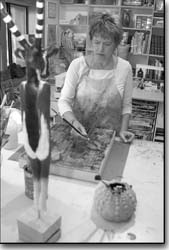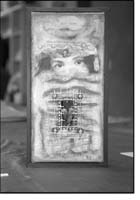|
|
||||
|
Giving new life to old imagery by Jules Masterjohn Artistic productivity is a place of high regard for me. I marvel at those artists who dedicate themselves full time to their creative ventures, most content to be alone in their studios producing artwork. I am attracted to creative people and their studios because there is a part of me that deeply believes in this lifestyle choice. It is especially juicy to visit the studio of an artist whose work and creative process have some basic kinship to my own. Deborah Gorton is one such artist, and a recent visit to her studio was visually stimulating – sheets of handsome paper, books and boxes of intriguing objects everywhere. Deborah is prolific while producing a variety of imaginative and beautiful objects from greeting cards, refrigerator magnets and dolls to mixed-media sculpture and collaged canvases incorporating found and bought objects. “I collect old imagery from all sorts of places, like finding things on eBay. I finally said to my mother, ‘if you have old things, please don’t throw them away.’ She gave me a box of stuff – photographs, old stamps, passports – it’s been a treasure chest for me.” Mostly employing the techniques of collage and assemblage, Deborah’s current work utilizes many different materials and requires her to know numerous technical processes and products. Surrounded by a dozen of her newest pieces, we talked about our common sensibilities and the joy of creating. JM: From book pages, pastels and paint to thread, wire, fossils and coins, you use many different tactile and suggestive materials. Is it challenging to move between so many different materials and processes? Deborah: I like stretching myself and love to experiment. I love getting an idea in my head and figuring it out, seeing if I can accomplish it. Finishing a piece can be hard because a new idea might pop up and I’ll want to pursue it. I like being able to add a three-dimensional aspect to my two-dimensional work. So just throwing that all together is the challenge that interests me. I don’t have much interest in just painting a picture and leaving it at that. I am always trying something new. JM: You use materials that have pretty powerful implications … fossils referencing prehistory and earth processes, the bound figures, the stacked dice pieces. It seems to me there is a richness to the layered images, juxtaposition of object and text that quietly tells a story and invokes curiosity. Deborah: I am drawn to old materials, things that have been around awhile that have been handled. I like earth tones because they feel aged. I want my work to look like it has some history. Each of these elements helps to add a bit of a story to the pieces. I like the mystery of different layers, making something look like you can’t quite tell just exactly what is there … is there meaning behind it or not? I want people to find their own meaning in the little bits of story through the text, the book pages and the words. JM: Looking at these mixed-media pieces in front of us, it is as if you are creating a past that never happened. Seeing your work I feel this sense of familiarity that mimics a memory. Deborah: I like it that way; it’s more like a fictional story. If I put my grandmother’s picture in a piece, it would be too closely connected to me. JM: This collage-covered canvas with the opening in the center, “Heart Throbs,” is intriguing. Tell me about it.
JM: This collage-covered canvas with the opening in the center, “Heart Throbs,” is intriguing. Tell me about it. Deborah: This piece began with the eyes, then I found a page in a book that started telling a love story, so I decided to create a little niche with the heart. It became almost a story about a broken love affair or a broken heart. If I can just get out of the way and let it happen, the pieces kind of create themselves. It’s when I try and think too much that it gets clogged up and stymied. The pieces I like the best are the ones where I can say that I stepped out of the way. JM: You make lovely surfaces, the subtlety is beautiful. It is aesthetically pleasing to my eye to see the different qualities of matte and shiny surfaces. The way the light plays off the surfaces reveals the information between the layers but the words or information can’t quite be accessed. Why is that? Deborah: I do like that, too – like an old wall with layers of wallpaper peeling off. How many stories has this wall told? I don’t know why, it just appeals to me. Maybe because I feel like I am peeling away my own layers. My work is an expression that I create just for myself. I don’t know, it’s something I am compelled to do right now, and I have to put it out there to sell because otherwise I don’t know what to do with all the artwork. It just piles up! JM: So the marketing has a practical concern, stuff comes in, art goes out! That is a huge concern for many artists. Having a venue in which to sell is important, isn’t it? Deborah: I find it very fulfilling to have people buy my work and to find out that they own several pieces. That helps when I have those days of self-doubt about what I am doing. JM: With your love of newness, is there something on the horizon that you want to learn? Deborah: I am constantly reading articles and trying things other people have done. I hear about things that people are adding to their work and I think, “Ooooo, I want to try that.” I am assimilating, taking workshops and involved in my own trial and error. That’s part of my need to constantly experiment … that’s what keeps it fun! Deborah Gorton’s “Wild Hair Tribe Dolls” are on display at Lime Berry, 925 Main Ave., Durango, open daily at 10 a.m. •
|



